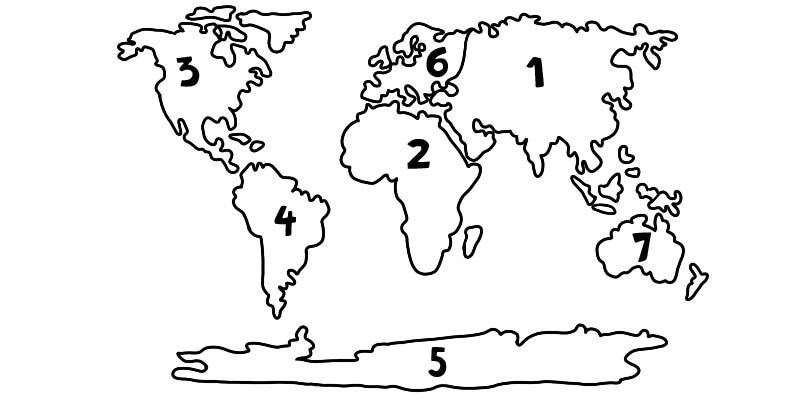A continent is a massive area of land that is separated from others by water or other natural features. There are seven continents on our planet. They are (from largest in size to the smallest): Asia, Africa, North America, South America, Antarctica, Europe, and Australia. Together, they cover one-third of the world, with the oceans covering the other two thirds.

1. Asia
Asia is the world’s largest continent and covers one-third of all the land on Earth. It is home to about two-thirds of the world’s people. Asia stretches from the Arctic Circle in the north to the warm, tropical waters of the Indian Ocean in the south, to the Ural Mountains in the west and the Pacific Ocean in the east. The world’s highest mountains, the Himalayas, are in Asia as well as the highest plateau, the Tibetan Plateau. The Dead Sea is the world’s lowest point on land. Asia is home to animals such as Asian elephants, tigers, and giant pandas.
2. Africa
Africa is the second largest continent after Asia. It lies between the Atlantic and Indian Oceans. To the north is the Mediterranean Sea and to the south is the Southern Ocean. The northern part is covered by Earth’s largest desert, the Sahara. To the east is the world’s longest river, the Nile. Africa has 54 countries, more than any of the other continents. These countries are home to some of the most ancient cultures in the world. Africa is widely regarded to be the continent where humans originated. Africa has large animal reserves (parks) like the Serengeti, Masai Mara, and Kruger. The reserves are home to wildlife, such as lions, rhinos, zebras, and elephants.
3. North America
North America is Earth’s third largest continent. It is made up of the United States of America, Canada, and Mexico down to Panama, as well as the Caribbean islands. It has coasts on the Pacific and Atlantic Oceans and is connected to South America by land. North America has natural wonders like Grand Canyon and Yellowstone National Park. Greenland, the world’s biggest island, is also in North America, although it belongs to the European country of Denmark. The human-made Panama Canal divides the continents of North and South America. Animals that are found in North America include the moose, raccoon, and bears.
4. South America
South America is Earth’s fourth largest continent. It stretches from just above the equator down to the Antarctic. It is connected to North America by land. The Amazon River runs through South America and is surrounded by the world’s largest rainforest. The continent has rainforests, deserts like the Atacama, the world’s driest desert, and the Andes, the world’s longest mountain range. South America is home to the world’s highest waterfall Angel Fall. There are glaciers in the south. South America includes 12 independent countries – Argentina, Brazil, Chile, Columbia, Eucador, Guyana, Paraguay, Peru, Suriname, Uruguay, Venezuela, and French Guiana. The largest country is Brazil. The potato originates in South America, along with chocolate, pineapple, and peanuts. South American animals include llamas, the capybara, which is the world’s largest rodent, and the Andean condor, which has the largest wingspan of any bird.
5. Antarctica
Antarctica is the continent at the South Pole and about 98% of Antarctica is covered by ice that averages about 1.6 kilometers in thickness. It is the fifth largest continent and is surrounded by the Southern Ocean. It is the coldest, driest and windiest continent. As the temperature in Antarctica can dip to below −112° F (-80°C), no one lives there all the time. No country owns Antarctica. There are no permanent residents on this island, but only a few thousands of people, who live here at the research stations found across the continent. Scientists from 29 countries visit research stations to carry out experiments throughout the year. Despite the cold, Antarctica is home to animals such as penguins, seals, and seabirds.
6. Europe
Europe is earth’s second smallest continent after Australasia but it has one-quarter of the world’s population. Europe’s western coast is on the Atlantic Ocean. There are 44 European countries, which have distinct ethnic groups and languages. The climate ranges from very cold winters in Scandinavia to warm areas in the south, in countries like Spain and Italy. Europe is divided from Africa by the Mediterranean Sea. The Ural Mountains divided Europe and Asia, but sometimes the two continents are described as one region called Eurasia.
7. Australia and Oceania
Australia is the smallest continent and lowest-lying human-inhabited continent on Earth. As Australia is mostly on a single landmass, it is also referred to as an “island” continent surrounded by oceans. It includes Australia, New Zealand, New Guinea, and some of the small nearby islands such as Tasmania, the Aru Islands, and the Raja Ampat Islands geologically. Australia is bordered by the Indian Ocean on the west and the Pacific Ocean on the east. Australia has no active volcanic regions. Australia has been cut off from the other continents are so long that it has animals that are not found anywhere else on Earth, like the kangaroo and koala. The region is known as Oceania includes thousands of tiny islands that are not part of any continent, spread out over a vast area of the Pacific Ocean.